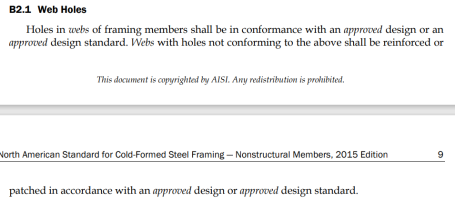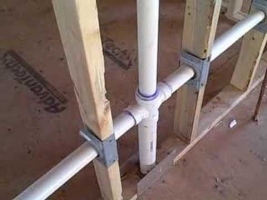-
Welcome to The Building Code Forum
Your premier resource for building code knowledge.
This forum remains free to the public thanks to the generous support of our Sawhorse Members and Corporate Sponsors. Their contributions help keep this community thriving and accessible.
Want enhanced access to expert discussions and exclusive features? Learn more about the benefits here.
Ready to upgrade? Log in and upgrade now.
You are using an out of date browser. It may not display this or other websites correctly.
You should upgrade or use an alternative browser.
You should upgrade or use an alternative browser.
Notching Metal Studs
- Thread starter jar546
- Start date
I've only ever run across this type of construction twice, and both were in commercial settings, so I had to look it up. Here's what I found:
R603.2.6 Web holes, web hole reinforcing and web hole
patching. Web holes in wall studs shall comply with the
conditions as prescribed in AISI S230, Section A4.5. Web
holes not in conformance to the conditions as prescribed in
AISI S230, Section A4.5 shall be reinforced in accordance
with the provisions of AISI S230, Section A4.6 or patched
in accordance with the provisions of AISI S230, Section
A4.7.
R603.3.4 Cutting and notching. Flanges and lips of cold-
formed steel studs and headers shall not be cut or notched.
R603.2.6 Web holes, web hole reinforcing and web hole
patching. Web holes in wall studs shall comply with the
conditions as prescribed in AISI S230, Section A4.5. Web
holes not in conformance to the conditions as prescribed in
AISI S230, Section A4.5 shall be reinforced in accordance
with the provisions of AISI S230, Section A4.6 or patched
in accordance with the provisions of AISI S230, Section
A4.7.
R603.3.4 Cutting and notching. Flanges and lips of cold-
formed steel studs and headers shall not be cut or notched.
steveray
SAWHORSE
Yep...AISI....I know the guy that used to be their code guy here in CT....But there is really not much you can do with steel studs without the designers blessing...
Sifu
SAWHORSE
- Joined
- Sep 3, 2011
- Messages
- 3,516
I know of nothing specific for interior non-load bearing in the IRC. Not sure if ASTM 754 covers it or not because I don't have it, but I believe that would be the standard, as referenced by AISI. However, not sure either is referenced in the IRC. Might as well use spaghetti. Al dente would be better than fully cooked. May be something from the manufacturer or an ESR.
mtlogcabin
SAWHORSE
R702.3.3
Cold-formed steel framing supporting gypsum board and gypsum panel products shall be not less than 11/4 inches (32 mm) wide in the least dimension. Nonload-bearing cold-formed steel framing shall comply with AISI S220. Load-bearing cold-formed steel framing shall comply with AISI S240.
 www.ferguson.com
www.ferguson.com

Cold-formed steel framing supporting gypsum board and gypsum panel products shall be not less than 11/4 inches (32 mm) wide in the least dimension. Nonload-bearing cold-formed steel framing shall comply with AISI S220. Load-bearing cold-formed steel framing shall comply with AISI S240.
PROFLO® 6 x 1-1/2 in. 18 ga Steel Stud Guard | Ferguson
Find the PROFLO® 6 x 1-1/2 in. 18 ga Steel Stud Guard at Ferguson online for delivery or pickup at a Ferguson store near you.
P2603.2.1
In concealed locations, where piping, other than cast-iron or galvanized steel, is installed through holes or notches in studs, joists, rafters or similar members less than 11/4 inches (31.8 mm) from the nearest edge of the member, the pipe shall be protected by steel shield plates. Such shield plates shall have a thickness of not less than 0.0575 inch (1.463 mm) (No. 16 Gage). Such plates shall cover the area of the pipe where the member is notched or bored, and shall extend not less than 2 inches (51 mm) above sole plates and below top plates.
mtlogcabin
SAWHORSE
"The Cold-Formed Steel Engineers Institute has an answer in CFSEI Tech Note G500-11 (“Guidelines for Inspecting Cold-Formed Steel Structural Framing in Low Rise Buildings”). Under section 1.0 Materials, paragraph 1.3 Web Holes, CFSEI Tech Note G500 says this:
“The size of a web hole should not be larger than one-half the web depth, or 2-½” maximum in the web direction and not more than 4-½” long in the member direction.”
The Code Compliance Research Report, CCRR-0224, from Intertek says the same in paragraph 3.2:
“Web punch-out widths shall not exceed 2.5 inches, or half of the member depth. Web punch-out length shall not exceed 4.5 inches.”
The ICC Evaluation Service, a subsidiary of the International Code Council, recommends a smaller hole limit:
1-½”, according to the ICC-ES Evaluation Report, ESR-4205.
Pat Ford, Steel Framing Industry Association (SFIA) technical director, says that a few limited holes within CFS studs may be safely executed in the field. But, those cut studs will still need a thorough engineering review, he says. Some may need to be replaced."

 buildsteel.org
buildsteel.org
“The size of a web hole should not be larger than one-half the web depth, or 2-½” maximum in the web direction and not more than 4-½” long in the member direction.”
The Code Compliance Research Report, CCRR-0224, from Intertek says the same in paragraph 3.2:
“Web punch-out widths shall not exceed 2.5 inches, or half of the member depth. Web punch-out length shall not exceed 4.5 inches.”
The ICC Evaluation Service, a subsidiary of the International Code Council, recommends a smaller hole limit:
1-½”, according to the ICC-ES Evaluation Report, ESR-4205.
Pat Ford, Steel Framing Industry Association (SFIA) technical director, says that a few limited holes within CFS studs may be safely executed in the field. But, those cut studs will still need a thorough engineering review, he says. Some may need to be replaced."

Cutting and Notching in Cold-Formed Steel Framing - BuildSteel.org
This article addresses how big cut holes can be and whether cutting in the field is a good idea.
Yankee Chronicler
SAWHORSE
I've only ever run across this type of construction twice, and both were in commercial settings, so I had to look it up. Here's what I found:
R603.2.6 Web holes, web hole reinforcing and web hole
patching. Web holes in wall studs shall comply with the
conditions as prescribed in AISI S230, Section A4.5. Web
holes not in conformance to the conditions as prescribed in
AISI S230, Section A4.5 shall be reinforced in accordance
with the provisions of AISI S230, Section A4.6 or patched
in accordance with the provisions of AISI S230, Section
A4.7.
R603.3.4 Cutting and notching. Flanges and lips of cold-
formed steel studs and headers shall not be cut or notched.
Both of those sections apply to load-bearing walls and partitions. The voice in the video asked about NON-load-bearing walls. I can't find anything in the IRC to address this question, so the answer is probably to defer to the manufacturer's installation instructions (if there are any). From a practical perspective, I can't imagine doing that without following up with a steel strap on each flange to span the notches.
Interesting... I bet the product comes with a listing and instructions, which probably include some limitations even for non-loadbearing walls...Both of those sections apply to load-bearing walls and partitions. The voice in the video asked about NON-load-bearing walls. I can't find anything in the IRC to address this question, so the answer is probably to defer to the manufacturer's installation instructions (if there are any). From a practical perspective, I can't imagine doing that without following up with a steel strap on each flange to span the notches.
Yankee Chronicler
SAWHORSE
1-½”, according to the ICC-ES Evaluation Report, ESR-4205.
Where did you see that in ESR-4205? I can't find it.
Inspector Gadget
REGISTERED
How is that different from wood framing in residential construction when the plumber way over cuts the hole.
Oh, come. That NEVER happens.
All that text was directly quoted from the article I posted the link to.Where did you see that in ESR-4205? I can't find it.
Yankee Chronicler
SAWHORSE
All that text was directly quoted from the article I posted the link to.
Okay, but I downloaded ESR-4205. It doesn't say what you said it says.
I didn't say anything. I literally copy/pasted that whole statement from that website.Okay, but I downloaded ESR-4205. It doesn't say what you said it says.
Sifu
SAWHORSE
- Joined
- Sep 3, 2011
- Messages
- 3,516
I don't see any actual code in the IRC, nor a referenced code that has the answer. I would be looking at MFR, and ESR (if it is covered by one). But the bigger problem is that it sure seems to be a legitimate question, with little to go on for a citable answer. There are 41 pages in the 2018 IRC for cold form metal framing, yet it isn't covered? I don't see many metal stud framed projects in residential, but it has been awhile since I had occasion to look, so maybe that has changed and/or is a regional thing, but I have always questioned why there are 41 pages of code for it in the prescriptive code in the first place. Now I learn they didn't cover this. I guess the projects I have seen were better than the installation in the OP so I never needed this answer.
Could we go to AISI, ASTM or CFSEI (not seen that one before)? Maybe, but with 41 pages I am thinking it should be covered without us or even less likely, the contractors and homeowners, going to those documents.
Could we go to AISI, ASTM or CFSEI (not seen that one before)? Maybe, but with 41 pages I am thinking it should be covered without us or even less likely, the contractors and homeowners, going to those documents.
BuildingOfficial89
REGISTERED
Looking at the photo, it appears to be a double wall, so why didn't the designer put enough space between the studs to create a pipe chase?
jar546
CBO
That is what I asked the contractor. No response.Looking at the photo, it appears to be a double wall, so why didn't the designer put enough space between the studs to create a pipe chase?
Yankee Chronicler
SAWHORSE
Looking at the photo, it appears to be a double wall, so why didn't the designer put enough space between the studs to create a pipe chase?
That is what I asked the contractor. No response.
What do the approved construction documents show? It's difficult (but not impossible) to imagine a designer calling for a double wall with plumbing in it and not leaving enough space for the pipes. Is it possible the contractor put one or both lines of studs in the wrong place?
x

